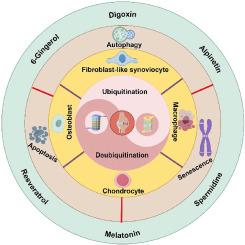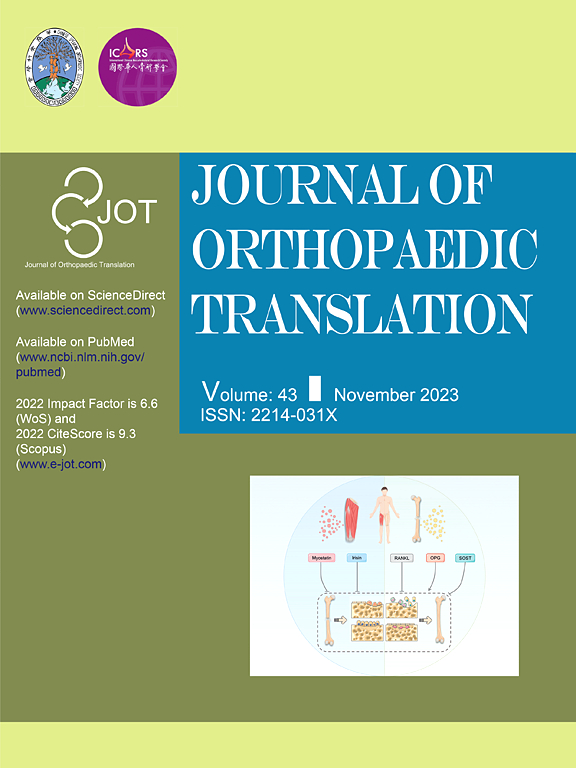泛素化和去泛素化:对骨关节炎发病机制和治疗的影响
IF 5.9
1区 医学
Q1 ORTHOPEDICS
引用次数: 0
摘要
骨关节炎(OA)是一种影响多种细胞和相关细胞外基质(ECM)的退行性疾病。软骨细胞和细胞外基质共同构成了关节软骨组织。任何影响软骨细胞活性和破坏软骨细胞 ECM 代谢平衡的因素都会导致关节软骨无法发挥正常功能。关节软骨下骨和关节软骨必须协调一致才能抵抗足够的摩擦和机械应力,因此关节软骨下骨病变会加重关节软骨缺损,反之亦然。滑膜细胞,包括关节处的成纤维细胞样滑膜细胞(FLSs)和滑膜巨噬细胞,也是导致 OA 低度慢性进行性炎症的重要因素。调节滑膜巨噬细胞的表型转化已成为临床治疗 OA 的另一个可能靶点。泛素化和去泛素化是人体内主要的蛋白质翻译后修饰途径,广泛参与多种信号通路和生理过程。自然,它们在 OA 的发生和发展过程中也起着非常重要的调控作用。本综述总结了这些作用,包括(A)调节软骨细胞、FLSs 和成骨细胞的衰老和凋亡;(B)调节 ECM 降解;(C)调节巨噬细胞的表型转化;(D)调节骨骼肌和脂肪组织。此外,还列出了用于治疗 OA 的泛素化靶向药物。本文的转化潜力:本文研究了骨关节炎(OA)中泛素化的相关途径,包括软骨细胞、成骨细胞、FLSs和巨噬细胞的衰老、凋亡和自噬。其中,一些泛素化相关靶点有望成为 OA 临床治疗的有效方法。此外,还讨论了在 OA 发生和发展过程中,局部关节区域与其他组织(包括骨骼肌和脂肪组织)之间的复杂关系。除了关节本身之外,这些来自肌肉骨骼组织的肌动因子和脂肪因子都有望成为治疗 OA 的有效靶点。此外,心血管组织分泌的肌动因子也将显示出潜在的治疗效果。如果通过运动来改变血清中这些泛素化相关靶点的含量,会不会为治疗 OA 或防止 OA 持续恶化提供新的思路呢?本文章由计算机程序翻译,如有差异,请以英文原文为准。

Ubiquitination and deubiquitination: Implications for the pathogenesis and treatment of osteoarthritis
Osteoarthritis (OA) is a degenerative disease that affects multiple cells and associated extracellular matrix (ECM). Chondrocytes and chondroextracellular matrix together constitute articular cartilage tissue. Any factors that affect the activity of chondrocytes and destroy the metabolic balance of the chondrocyte ECM will lead to the inability of articular cartilage to perform normal functions. The articular subchondral bone and articular cartilage must be coordinated to resist enough friction and mechanical stress, so the articular subchondral bone lesion will aggravate the articular cartilage defect and vice versa. Synoviocytes, including fibroblast-like synoviocytes (FLSs) and synovial macrophages at the joint, are also important factors that cause low-grade chronic progressive inflammation of OA. Regulation of phenotype transformation of synovial macrophages has become another possible target for the clinical treatment of OA. Ubiquitination and deubiquitination are the main post-translational protein modification pathways in the human body, which are widely involved in multiple signaling pathways and physiological processes. Naturally, they also play a very important regulatory role in the occurrence and development of OA. These effects are summarized in this review, including (A) regulating the aging and apoptosis of chondrocytes, FLSs and osteoblasts; (B) regulation of ECM degradation; (C) regulation of macrophage phenotypic transformation; (D) modulation of skeletal muscle and adipose tissues. Ubiquitination targeting drugs for OA treatment are also listed. Depending on the high efficiency of ubiquitination and deubiquitination, understanding OA-related ubiquitination pathways can help design more efficient drugs to treat OA and provide more potential targets for clinical treatment.
The Translational Potential of This Article.
In this paper, the ubiquitination-related pathways in osteoarthritis (OA), including aging, apoptosis and autophagy in chondrocytes, osteoblasts, FLSs and macrophages were investigated. In particular, several ubiquitination-related targets are expected to be effective approaches for OA clinical treatment. In addition, in the process of OA occurrence and development, the complex relationship between the local joint area and other tissues including skeletal muscle and adipose tissue is also discussed. These myokines and adipokines from musculoskeletal tissues are all expected to become efficient targets for OA treatment apart from the joint itself. In addition, those myokines secreted by cardiovascular tissues would show potential therapeutic effects as well. What if altering the contents for these ubiquitination-related targets in the serum through exercise will provide a new idea for OA therapy or prevent OA from deteriorating continuously?
求助全文
通过发布文献求助,成功后即可免费获取论文全文。
去求助
来源期刊

Journal of Orthopaedic Translation
Medicine-Orthopedics and Sports Medicine
CiteScore
11.80
自引率
13.60%
发文量
91
审稿时长
29 days
期刊介绍:
The Journal of Orthopaedic Translation (JOT) is the official peer-reviewed, open access journal of the Chinese Speaking Orthopaedic Society (CSOS) and the International Chinese Musculoskeletal Research Society (ICMRS). It is published quarterly, in January, April, July and October, by Elsevier.
 求助内容:
求助内容: 应助结果提醒方式:
应助结果提醒方式:


